Sometimes you can get stuck in a rut and wonder how to keep your perennial gardens looking beautiful and colorful throughout the entire growing season.
Are you looking for perennials made easy? Like, super duper easy? Then this post is for you! Below I will show you how to design gorgeous ever-blooming flower beds that are full of year-round color.
One of the biggest benefits of growing perennials in your garden instead of annual flowers is that they last for many years. But the downside is that they only bloom for a short time.
People are always sending me photos of their boring all-green (e.g.: no flowers) gardens begging me for advice on how to make the bed look better.
They know something is wrong with it, but they aren’t sure what the problem is, or how to fix it.
They go on to explain that their perennial garden looks amazing for a few weeks every summer, but it’s dull and boring the rest of the year because nothing else ever blooms.
Don’t worry, this is very common for newbie gardeners, and it’s caused by something called flower fixation.
Ok, I just made up that term, but it’s a real problem! Let me explain…
In fact, garden centers usually only sell plants when they’re in full bloom. Once those plants are done blooming, they quickly disappear from the shelves (or go on the clearance rack, where I buy them, muahahaha!).
So, for example, when you walk into a garden center during the summer, the photo below is an example of what you might see…
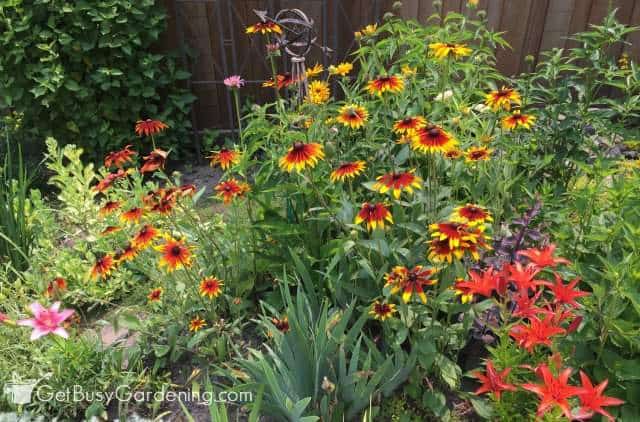
And most people think, “BAM, those flowers look amazing together so I’ll get them for my garden!“.
I mean, how could you go wrong with this amazing color combo, right?!?
Buuuut, since we love to buy plants that are blooming, we tend to forget to think about how long those flowers will last, or what time of the year they will bloom once they’re established in our garden.
And Flower fixation is the number one cause of dull, boring gardens 49 weeks out of the year.
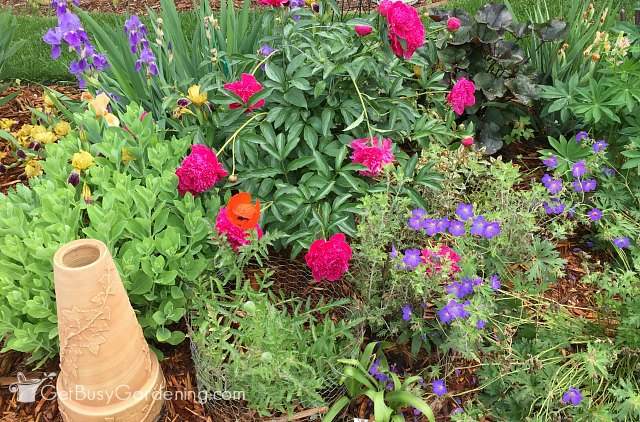
How To Create Gorgeous Perennial Flower Beds
So how can you fix the problem of the boring, mostly green perennial garden? The best thing to do is to first focus on the foliage, and not the flowers.
For example, take a look at this garden area…
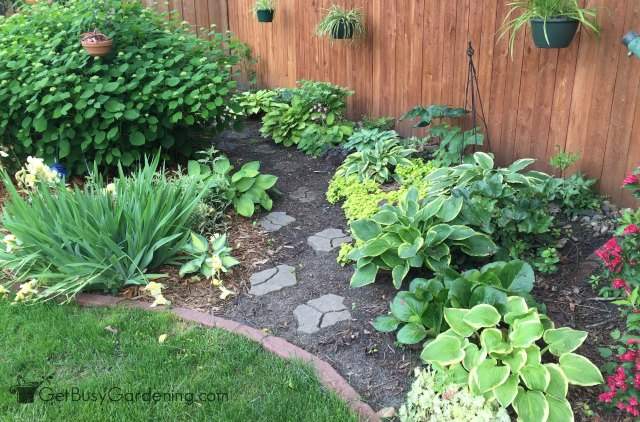
Even though there’s not really anything blooming, this perennial garden is still very colorful and beautiful.
That’s because I mixed in different colors and textures of foliage, rather than everything just being plain, boring green.
There are tons of gorgeous plants out there that add wonderful color to the garden, even when they’re not blooming.
I mean, am I right… BOOM!
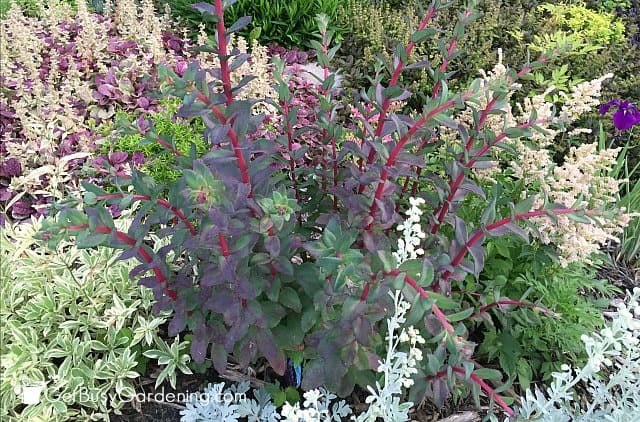
These days, perennial plants come in chartreuse, lime green, dark green, variegated, silver, burgundy, purple, pink, red… well, you can pretty much name your leaf color.
So, the next time you walk into the store, I challenge you to try to ignore the flowers that are all up-in-your-face, and focus only on the foliage.
Think about how you can mix the different foliage colors, textures, shapes, and sizes into your garden.
Try not to put perennials with the same color leaves next to each other, make it your goal to mix in as many contrasting textures and colors as you can.
If you already have a boring, green garden, then adding colorful foliage is the fastest way to rejuvenate the area and add tons of immediate color.
Ok, NOW we can focus on flowers (color AND bloom time!).
Tips For Creating An Ever-Blooming Perennial Garden
Ahhhh flowers, who doesn’t love to see a garden bursting with beautiful flowers?
But be careful, don’t let flower fixation set in again here.
The next thing to focus on is bloom time, NOT how the flowers look in the garden center. Make sure to read every single plant tag before you decide to buy it.
The tag will tell you when you can expect the plant to bloom once it’s established in your garden, and how large it will get (so you don’t have an ugly, overgrown looking bed full of huge plants in a few years).
Sometimes they even give you companion suggestions of what other plants look best when combined with this one.
Ok, wait. Let me show you one more example to really drive this home… take a look at the garden area below.
Only one flower is blooming, but look at that amazing, bold contrast of the orange lily against the backdrop of dark purple perennials and variegated sedum foliage, with the variegated iris spikes in the middle.
Related Post: How To Transplant Plants In Your Garden (5 Steps)
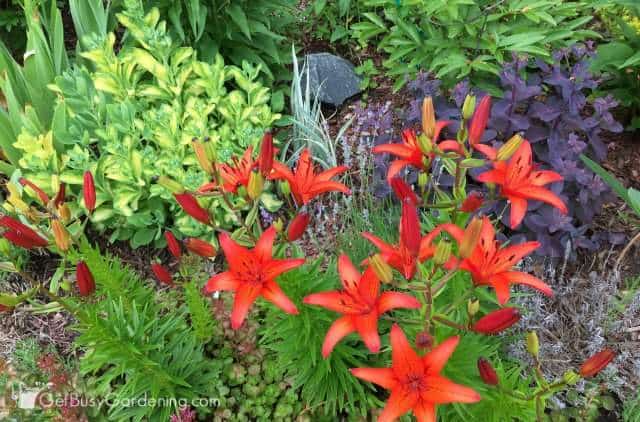
YES! That’s what I’m talking about!
AND, this area looks just as gorgeous in early spring when my irises and peonies are blooming, as it does in the fall once the sedum and lavender flowers steal the show.
See what I mean?
So include perennials that bloom at different times throughout the season. And mix them together as much as you can.
I try not to plant more than 2-3 plants that will flower at the same time next to each other. I like to layer in as much color, height, and texture as I can so my gardens are ever-blooming and gorgeous through the entire growing season.
Ever-blooming color, mixed with all of your contrasting foliage, will create eye-popping perennial flower beds that will be the envy of all your friends and neighbors.
Related Post: 19 Long Blooming Perennials For A More Beautiful Flower Garden
Four Season Perennial Gardens
Flower fixation usually leads to gardens that are gorgeous during the peak of summer… but dull and boring in the spring, fall, and winter.
So, as you select your perennials, think of what your garden will look like during the entire 12 months of the year, and plant accordingly.
Here are some snaps of a few of my perennial gardens through all four seasons of the year.
Moving left to right starting on top, these collages show you what spring, summer, fall, and winter look like in each of these four garden areas.
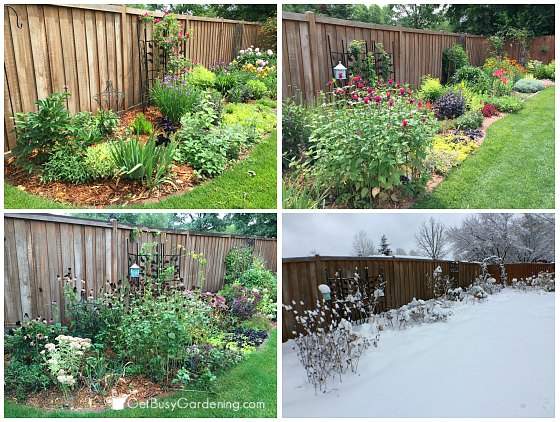

You may never think about what your garden will look like during the winter, but I love to leave a lot of my cleanup chores until spring.
Leaving tall plants in the landscape creates beauty during the winter, and is also great for wildlife (the birds and squirrels are very active in my yard all winter long).
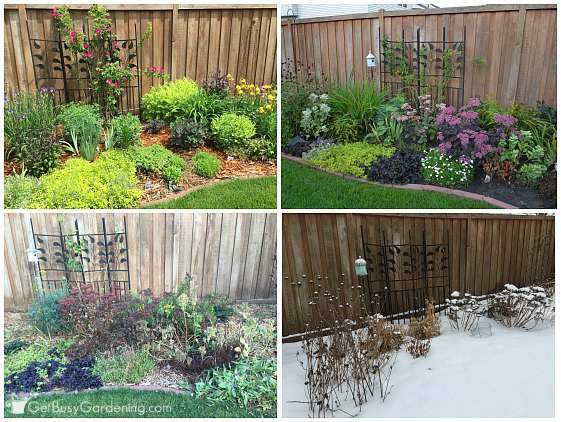
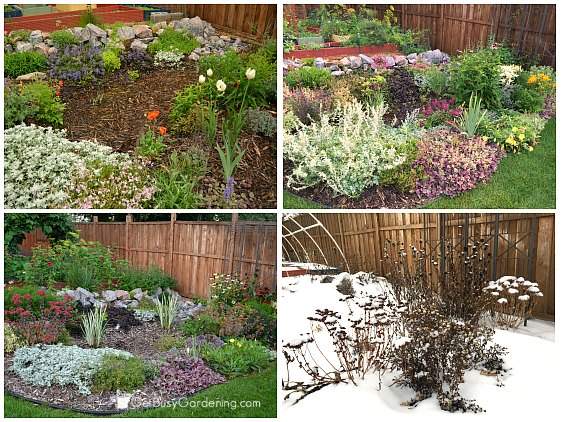
Garden Perennials For Every Season
To help get you started creating your own year-round flower gardens, below I’ve listed some common plants for each season to give you ideas, and get your creative juices flowing.
Early Spring Color
Spring blooming bulbs (like tulips, crocus, and daffodils, for example) will add the first splashes of color in early spring.
Creeping phlox, ajuga, bleeding heart, and colorful foliage plants (like sedums) won’t be far behind.
Related Post: When & How To Plant Your Spring Bulbs
Spring & Early Summer Color
Flowering perennials like peonies, lupine, irises, hardy geraniums, spirea, honeysuckle, weigela, and poppies are great for spring and early summer blooms.
This is also when the foliage colors from hostas, coral bells, sedums, and lungwort really start to pop.
Summer Blooming Perennials
Lilies, coneflowers, hardy hibiscus, rudbeckia, butterfly weed, phlox, liatris, sage, black-eyed Susan… I could go on and on.
But honestly, nobody seems to have trouble finding summer perennial flowers. Be careful adding too much here though, this is the season where flower fixation can really take over.
Fall & Late Blooming Perennials
Sedum (the ones with colorful foliage are especially great for adding year-round color), rue, Russian sage, mums, turtlehead, Japanese anemone, and hardy aster are all beautiful fall flowers.
This is a great time to prune spent blossoms and burnt-out foliage from early perennials to help make the fall bloomers and their foliage really stand out.
Perennials For Winter Interest
Leave tall plants like coneflowers, astilbe, rudbeckia, sedum, and hydrangea in the garden to add winter interest.
Some of the flowers contain seeds that feed the birds too, which adds life and movement to your otherwise boring winter landscape.
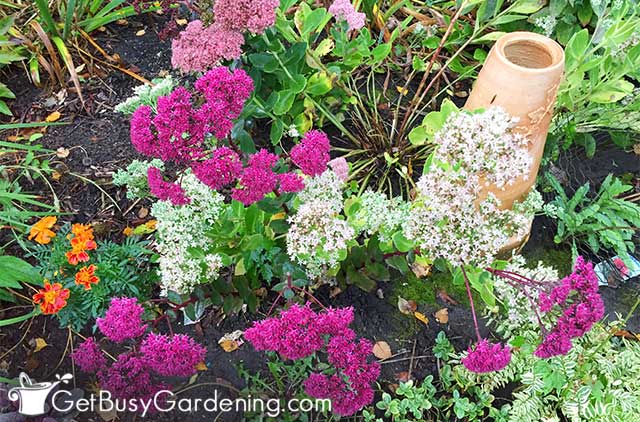
Maintenance Tips For Perennials Made Easy!
Designing eye-popping perennial beds is the first step. But regular maintenance is the key to keeping them looking amazing. Here are a few quick tips to make it easy for you.
Keep The Weeds At Bay
Mulching your beds will help keep the weeds from taking over, and make maintenance much easier.
It also creates a lovely backdrop for perennials to really make the colors pop. I use a natural hardwood mulch that will break down slowly.
To make it a snap to pull out pesky weeds, I highly recommend getting yourself a Hori Hori knife and also a Cobrahead weeder.
I’ve used a lot of gardening tools over the years, and these are two of the best hand weeding tools I’ve ever used.
Feed Your Plants
Perennials need a lot of energy to look their best, so make sure you fertilize them during the spring and summer months.
I like to use a mix of slow-release granules (either one made for flower gardens or an all purpose blend), and organic liquid fertilizers.
Some my favorite liquid options are compost tea and fish emulsion. Learn more about how to fertilize your flower beds here.
Prune Regularly
Pruning not only keeps the garden looking tidy, it also helps plants look their best by growing bushy, full, and compact, and it can encourage more flowers too.
I recommend trimming your perennials at least once a month to remove any spent flowers and burnt out foliage.
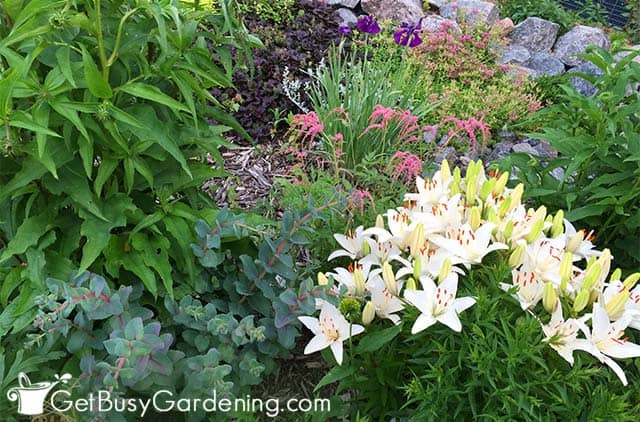
Stake Your Plants
Some perennials can get a little top-heavy when they’re covered in gorgeous blooms, and can flop to the ground under all that weight.
To keep them blooming longer, and your garden looking it’s best, stake any plants that need the extra support.
I find that wire tomato cages or grow through hoops work great for most of my plants. For larger ones, I use heavy-duty metal stakes for extra support.
Related Post: How To Support Peonies To Keep Them From Falling Over
Mixing several plants from this list into one area will ensure your perennial beds will be popping with color all year long, and ever-blooming through the entire growing season. Just remember, avoiding flower fixation will lead to amazing gardens.
Do you have any tips to add to this post about perennials made easy? Please share them in the comments section below.
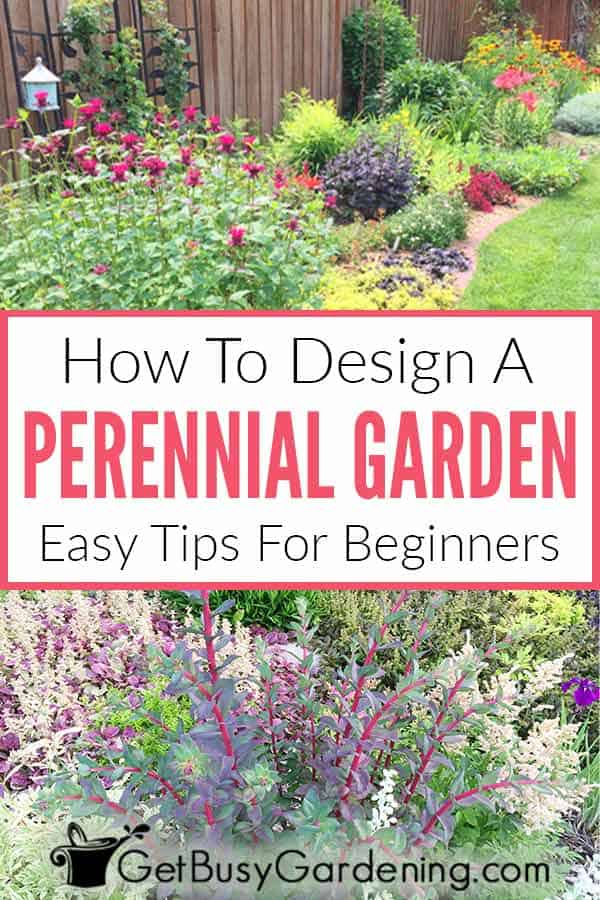

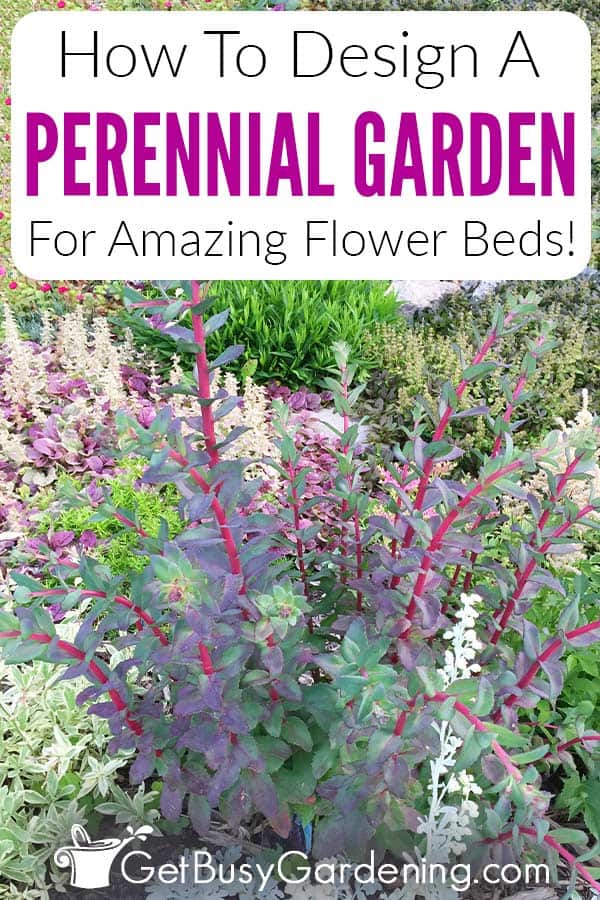
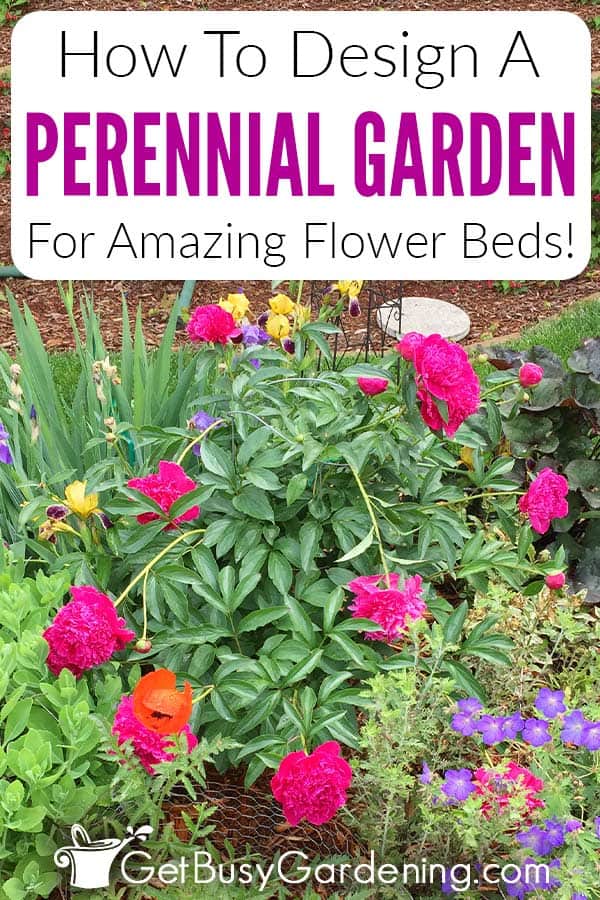
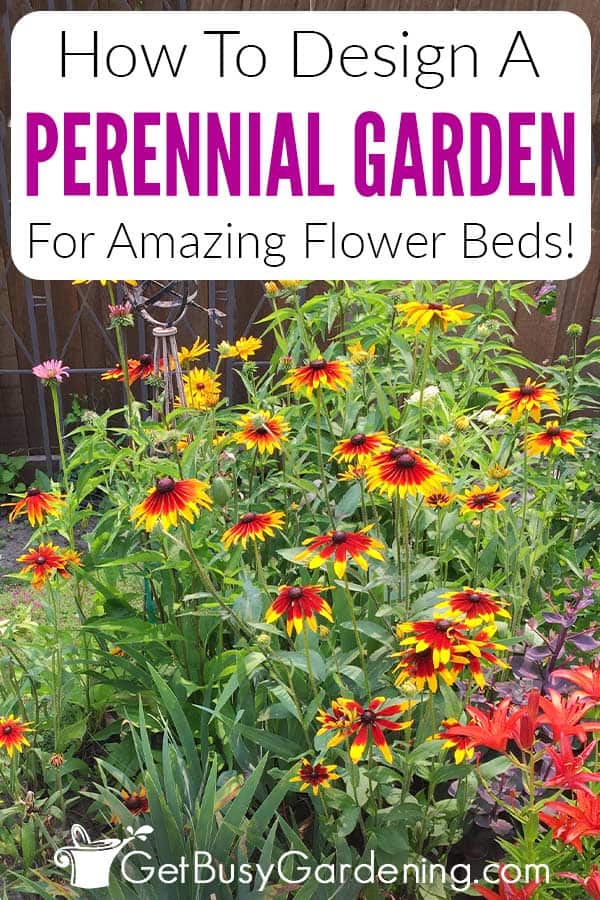
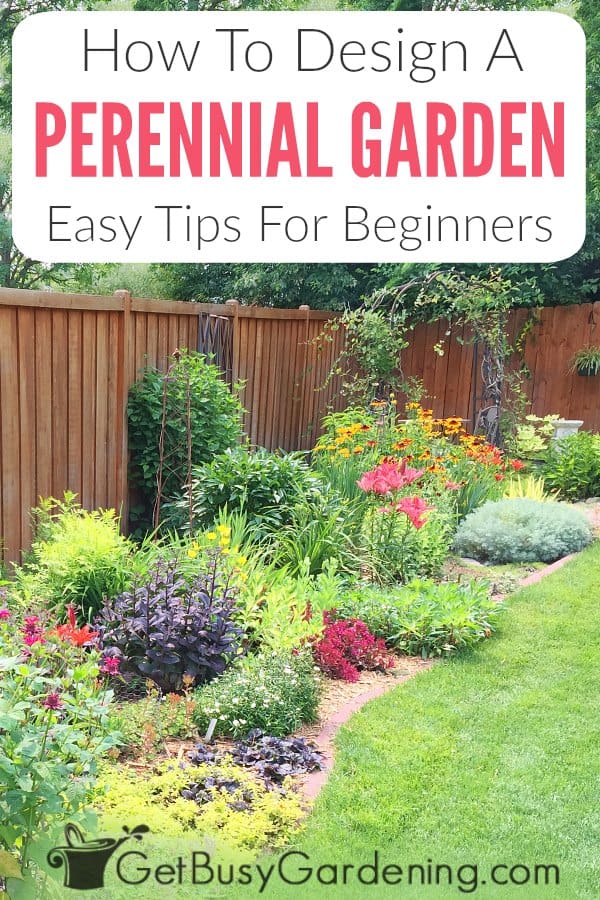
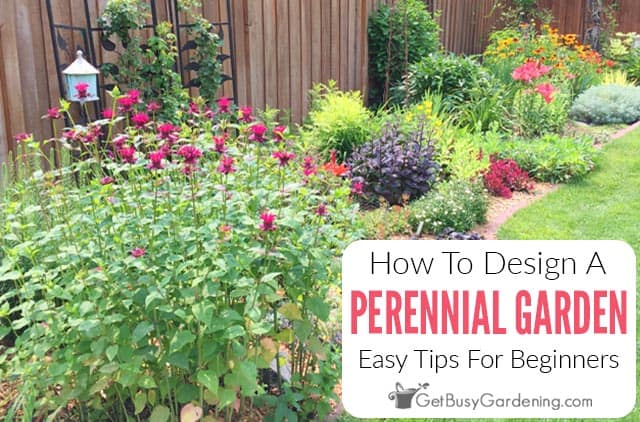


L. Barber says
So happy to have found this info with great pictures featuring the seasons and blooming perennials! The most help I’ve found yet!
Thank you!
Amy Andrychowicz says
You’re welcome! Thanks for much for the lovely comment. So happy to hear that you found my perennial garden design article so helpful! 🙂
Ivory says
I just found and joined your site. I am so happy I did, because you are so talent and creative. I love, love, love your garden, and all the tips, advice, plants and pictures of your beautiful garden. I am always out in my garden trying to get it to look like yours and other pictures I’ve seen. Thanks to you, I just might be able to get it to look like the wow’s and haaaa’s that I been striving for. Thank you so much.
Amy Andrychowicz says
Awe shucks! Thanks for your nice comment, and I’m so glad to hear you love my gardens! Follow these tips, and you’ll have the perennial garden of your dreams in to time! 🙂 Good luck, and have fun!
feijoa says
The images you have shown above of the garden is so nice. All the plants are very beautiful. But can you tell me how do you take care of all the beautiful plants?
Amy Andrychowicz says
Thank you! These are all pretty low maintenance perennials, so not much maintenance is required except for pruning and mulching. But I am always sharing tips for caring for your garden, so check out my Flower Gardening page for tons of tips, and watch for updates there! 🙂
feijoa says
Oh that’s great….these low maintenance perennials are then the right choice for me as i don’t get much time in my busy schedule to take much care of plants. Thank you. I must say that you are truly gifted!
Amy Andrychowicz says
Awe, thanks so much, that is very sweet of you to say! 🙂
Sugar says
Beautiful! I have quite a bit of purple liatris growing here, but didn’t know what it was. Thank you for solving that mystery!
Amy Andrychowicz says
LOL, you are so welcome! I love the flower spikes of liatris.
Carlee says
The hubs and I just planted white coneflowers and black eye susans in our perennial garden in the hopes that they will spread.
Amy Andrychowicz says
Nice plant combo! The black eye susan will definitely spread, I deadhead mine to help keep them in control. The cone flowers will spread too, but not as aggressively. Hope they will both do well for you!
Tammy says
Excellent article! I’ve been gardening for a long time and still learned a few new things. Thanks so much!
Amy Andrychowicz says
You’re welcome! Glad to hear you enjoyed the article, and were able to learn a thing or two. 🙂
Rebecca says
This article is full of so much good information! Can you please tell me what plants are in the photo under the quote “I mean, am I right… BOOM!” Specifically, the red stemmed plant in the front and the mauve/pink in the back left? Thanks!
Amy Andrychowicz says
The one in front with the red stems is a sedum telephium ‘Red Cauli’. The mauve colored one is ajuga.
Donnette Long says
I’d like to see a picture of your garden with a list of what’s in them. You know number on the plant and a list to match. I’m just starting, and I love your gardens.
Amy Andrychowicz says
Thanks, I’m glad to hear you love my perennial gardens! 🙂 I will keep your idea of putting the numbers on a photo in mind, and see if I can do that at some point.
ann turrell says
Thank you for this Amy – It’s the only blog I’ve managed to find that offers really simple, useful advice. Just planting up 6 new beds – and am nearly bald scratching my head over them!
Amy Andrychowicz says
Awe, so nice of you to say! You’re very welcome! 🙂 Wow, 6 new flower garden beds? That’s wonderful!! Enjoy!
ann turrell says
Maybe not, Amy – I stuck my spade through two inches of lovely black top soil – straight into a pan of thick yellow clay – so i’ve now got to dig in two thousand litres of grit and compost before I can even start planting – ah, well- when my back is
aching l can sit and read your new book!
Amy Andrychowicz says
Oh no, that’s not a happy surprise to find in your perennial garden! I hope you will love the book! 🙂
Sabrina says
Wow. I cannot thank you enough for creating this blog post. I am a complete beginner gardener and always hated the look of flowerless gardens. I was just planning my overly flowerful garden when I came across this post. Thank you so much for saving me from doing a lot of work, in the wrong direction.
Amy Andrychowicz says
Yeah! You’re welcome, so glad to hear I could help you design more colorful, ever-blooming perennial gardens. 🙂
Elizabeth K says
This post was so helpful for an amateur gardener like me!
Amy Andrychowicz says
Wonderful, great to hear!
Jamilah says
I have a big yard with boring design when we moved, its a big square design of grass sorrounded with gray small rocks and 4 medium size of trees. You’re idea sounds perfect but need a lot of time and effort for my garden. Thank you for you’re tips.
Amy Andrychowicz says
You’re welcome! So glad you found this helpful. Good luck and have fun creating your new garden design! 🙂
Stephanie says
This is a great article for a newbie gardener. Thanks so much for the information!
Amy Andrychowicz says
Awesome, I’m so glad you found it helpful! You’re welcome.
Brieann says
Great information here, and such beautiful garden beds! I can’t wait to plan my yard for my bees! They will appreciate the constant food sources.
Amy Andrychowicz says
Thank you! Bees love native plants the best, so keep that in mind during your planning. Here’s a post I wrote about how to create a bee friendly garden that might help you out.
Kelly Carney says
Hi! What a great lesson! Can you tell me the names of the flowers you use in your garden or show us in a gardening format please?
Amy Andrychowicz says
I don’t have a formal design layout for this garden. All of the plants that are growing in there I have listed above in the post. 🙂
Cheryl DeMars says
Your flower beds are beautiful. I’m planning new garden beds this summer, and will take your knowledge with me when staking out the arrangements. Thank you for sharing your tips and photos.
Chemara
Amy Andrychowicz says
Thank you! Have fun building your new garden!